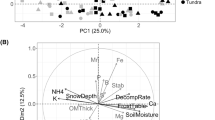Summary
Alders (Alnus crispa) in shrub tundra in northern Alaska showed significant regularity of spacing. Removal of neighboring alder shrubs stimulated nutrient accumulation and growth of remaining alders but did not stimulate nutrient accumulation or growth of any other shrub species. This demonstrates that neighboring alders competed with one another and that, when alders were removed, the resources made available were used preferentially by remaining alders rather than by the community in general. Neither patterns of seedling establishment nor patterns of frostrelated features could explain the regular distribution of alder. We suggest that regular patterns of plant distribution are restricted to sites of low-resource availability, because in these habitats (1) there is strong competition for a scarce resource, and (2) there are only one or a few dominant species to compete for these resources in a given canopy height or rooting depth.
Similar content being viewed by others
References
Batcheler CL (1971) Estimation of density from a sample of joint point and nearest-neighbor distances. Ecology 52:703–709
Beals EW (1968) Spatial pattern of shrubs on a desert plain in Ethiopia. Ecology 49:744–746
Britton ME (1967) Vegetation of the arctic tundra. In: Hanson HP (ed) Arctic biology. Oregon State Univ Press, Corvallis, pp 67–130
Chapin FS III (1980) The mineral nutrition of wild plants. Annu Rev Ecol Syst 11:233–260
Christensen NL (1977) Changes in structure, pattern and diversity associated with climax forest maturation in Piedmont, North Carolina. Am Midl Nat 97:176–188
Cooper CF (1961) Pattern in ponderosa pine forests. Ecology 42:493–499
Cox GW (1987) Nearest neighbor relationships of overlapping circles and the dispersion pattern of desert shrubs. J Ecol 75:193–199
Ebert TA, McMaster GS (1981) Regular pattern of desert shrubs: a sampling artifact. J Ecol 69:559–564
Epstein E (1972) Mineral nutrition of plants: principles and perspectives. John Wiley and Sons, New York
Fenner M (1985) Seed ecology. Chapman and Hall, London
Fonteyn PJ, Mahall BE (1978) Competition among desert perennials. Nature 275:544–545
Fonteyn PJ, Mahall BE (1981) An experimental analysis of structure in a desert plant community. J Ecol 69:883–896
Greig-Smith P (1964) Quantitative plant ecology. Butterworth, London
Grime JP (1977) Evidence for the existence of three primary strategies in plants and its relevance to ecological and evolutionary theory. Am Nat 111:1169–1194
Harper JL (1977) The population biology of plants. Academic Press, New York
Harrison AF, Helliwell DR (1979) A bioassay for comparing phosphorus availability in soils. J Appl Ecol 16:497–505
Jonasson S, Chapin FS III (1985) Significance of sequential leaf development for nutrient balance of the cotton sedge, Eriophorum vaginatum L. Oecologia 67:511–518
King TJ, Woodell SRJ (1973) The causes of regular pattern in desert perennials. J Ecol 61:761–765
King TJ, Woodell SRJ (1984) Are regular patterns in desert shrubs artifacts of sampling? J Ecol 72:295–298
Laessle AM (1965) Spacing and competition in natural stands of sand pine. Ecology 46:65–72
Nakagoshi N, Takamatsu S, Nehira K (1983) Post-fire vegetation at 21 years old stand in Otake, Southwestern Japan. Bull Biol Soc Hiroshima University 49:23–33
Phillips DL, MacMahon JA (1981) Competition and spacing patterns in desert shrubs. J Ecol 69:97–115
Pielou EC (1960) A single mechanism to account for regular, random and aggregated populations. J Ecol 48:575–584
Sokal RR, Rohlf FJ (1981) Biometry. WH Freeman, San Francisco
Schlesinger WH, Gill DS (1978) Demographic studies of the chaparral shrub Ceanothus megacarpus in the Santa Ynez Mountains, California. Ecology 59:1256–1263
Waisel Y (1971) Patterns of distribution of some xerophytic species in the Negev, Israel. Isr J Bot 20:101–110
Webber PJ (1978) Spatial and temporal variation of the vegetation and its productivity, Barrow, Alaska. In: Tieszen LL (ed) Vegetation and production ecology of an Alaskan arctic tundra. Springer, Berlin Heidelberg New York, pp 37–112
Woodell SRJ, Mooney HA, Hill AJ (1969) The behavior of Larrea divaricata (Creosote Bush) in response to rainfall in California. J Ecol 57:37–44
Author information
Authors and Affiliations
Rights and permissions
About this article
Cite this article
Chapin, F.S., McGraw, J.B. & Shaver, G.R. Competition causes regular spacing of alder in Alaskan shrub tundra. Oecologia 79, 412–416 (1989). https://doi.org/10.1007/BF00384322
Received:
Published:
Issue Date:
DOI: https://doi.org/10.1007/BF00384322




